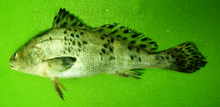Theblackspotted croaker(Protonibea diacanthus), also known in Australia as theblack jewfish,[3]is a species of marineray-finned fishbelonging to thefamilySciaenidae,the drums and croakers. This fish is found in theIndo-Pacificregion. It is the only species in themonospecific genusProtonibea.
| Blackspotted croaker | |
|---|---|

| |
| Scientific classification | |
| Domain: | Eukaryota |
| Kingdom: | Animalia |
| Phylum: | Chordata |
| Class: | Actinopterygii |
| Order: | Acanthuriformes |
| Family: | Sciaenidae |
| Genus: | Protonibea Trewavas,1971 |
| Species: | P. diacanthus
|
| Binomial name | |
| Protonibea diacanthus (Lacépède,1802)
| |
| Synonyms[2] | |
| |
Taxonomy
editThe blackspotted croaker was first formallydescribedin 1802 asLutjanus diacanthusby the FrenchnaturalistBernard Germain de Lacépèdewithout itstype localitybeing given.[4]In 1971Ethelwynn Trewavasclassified this species in the monospecific genusProtonibea.[5]This taxon has been placed in thesubfamilyOtolithinae by some workers,[6]but the 5th edition ofFishes of the Worlddoes not recognise subfamilies within the Sciaenidae which it places in theorderAcanthuriformes.[7]
Catalog of Fishesmentions that the monspecific genusMegalonibeamay be asynonymofProtonibea,however, asProtonibeawas proposed as a genus byEthelwynn Trewavasin 1973 that name would be ajunior synonymofMegalonibea,[5]and it is treated as such by other authors. If that is the case then thebinomialfor this species should beMegalonibea diacantha,withMegalonibea fuscabeing a synonym ofM. diacantha.[8]
Etymology
editThe blackspotted croaker's genus name.Protonibeaprefixesprotos,meaning "first", withNibeaas its wide range and characteristics suggest that it may be close to the ancestral form ofNibeaand related genera. Thespecific name,diacanthus,means "two spined" as Hamilton originally described this species as a snapper in the familyLutjanidaewith 2 spines in the anal fin rather than 3.[9]
Description
editThe blackspotted croaker has the frontmost pores on its chin very close to the tip of the lower jaw and they are joined by a groove. The swimbladder has a shape like a carrot and has branched appendages along the whole of both its sides but none of these goes through thetransverse septum.Thedorsal finis divided by an incision with 9 or 10 spines supporting the fin to the front of the incision and a single spine and 22 to 25 soft rays supporting the fin to the rear of the incision. Theanal finhas 2 spines and 7 soft rays supporting it. This species reaches a maximum total length of 180 cm (71 in). There are between 3 and 5 broad dark vertical bands on the body and numerous small black spots on the head, dorsal part of the body and the dorsal andcaudal fins.These marking fade as the fish grows larger. Thepectoral,pelvic,anal and lower caudal fin are dark.[8]
Distribution and habitat
editThe blackspotted croaker has a wide Indo-Pacific distribution from thePersian Gulf(where it is consideredLeast Concern)[10]east into the Pacific Ocean where it extends north to Japan and south to northern Australia. In Australia their range extends fromOnslow, Western Australia,around the northern tropical coast as far asMackay, Queensland.[11]It is found in coastal waters, usually no deeper then 60 m (200 ft), over mud substrates. It occasionally enters estuaries and the tidal reaches of rivers.[1]
Commercial importance
editThe fish is considered a delicacy, it is prized inEast Asiabecause even though there is no evidence, some people actually think its organs are medicinal. The fish are most expensive in countries likeSingapore,Malaysia,Indonesia,Hong KongandJapan. This fish is known locally asTeliainOdia,and in 2020, fishermen fromOdishacaught one weighing around 22 kg (48 lb 8 oz). A pharmaceutical company purchased it ₹8000 per kg in an auction.[12]Similarly in 2019, another fishermen from Odisha caught a 10 kg (22 lb) fish and was sold ₹10,000 per kg.[13]In 2024, a Blackspotted croaker weighing around 25.36 kg (55 lb 15 oz) was caught in theSundarbans,Bangladesh.This exceptional catch garnered interest and fetched a high price, negotiated between ৳375,000 to ৳400,000.[14]In 2023,Gujaratannounced Blackspotted croaker as the state fish.[15]
References
edit- ^abSadovy, Y.; Janekikarn, S.; Chao, L.; Mok, H.-K.; Sasaki, K.; Liu, M.; Hoshino, K.; Sakai, T.; Nguyen Van, Q.; Santos, M.; Yang, C.-H.; Chen, M.-H.; Yeh, H.-M. & Liu, S.-H. (2020)."Protonibea diacanthus".IUCN Red List of Threatened Species.2020:e.T49188717A49227587.doi:10.2305/IUCN.UK.2020-1.RLTS.T49188717A49227587.en.Retrieved2 July2023.
- ^Froese, Rainer;Pauly, Daniel (eds.)."Protonibea diacanthus".FishBase.February 2023 version.
- ^Boating, fishing and marine > Fish species > Black jewfishNorthern Territory Government. Retrieved 20 February 2021.
- ^Eschmeyer, William N.;Fricke, Ron & van der Laan, Richard (eds.)."Species in the genusProtonibea".Catalog of Fishes.California Academy of Sciences.Retrieved3 July2023.
- ^abEschmeyer, William N.;Fricke, Ron & van der Laan, Richard (eds.)."Genera in the family Sciaenidae".Catalog of Fishes.California Academy of Sciences.Retrieved3 July2023.
- ^Kunio Sasaki (1989)."Phylogeny of the family Sciaenidae, with notes on its Zoogeography (Teleostei, Peciformes)"(PDF).Memoirs of the Faculty of Fishes Hokkaido University.36(1–2): 1–137.
- ^J. S. Nelson; T. C. Grande; M. V. H. Wilson (2016).Fishes of the World(5th ed.). Wiley. pp. 497–502.ISBN978-1-118-34233-6.Archived fromthe originalon 2019-04-08.Retrieved2023-07-03.
- ^abKunio Sasaki (2022). "Family Sciaenidae Croakers, Drums and Cobs". InPhillip C Heemstra;Elaine Heemstra; David A Ebert; Wouter Holleman;John E Randall(eds.).Coastal Fishes of the Western Indian Ocean Volume 3(PDF).South African Institute for Aquatic Biodiversity. pp. 389–414.ISBN978-1-990951-30-5.
- ^Christopher Scharpf & Kenneth J. Lazara, eds. (9 March 2023)."Series Eupercaria (Incertae sedis): Families Callanthidae, Centrogenyidae, Dinopercidae, Emmelichthyidae, Malacanthidae, Monodactylidae, Moronidae, Parascorpididae, Sciaenidae and Sillagidae".The ETYFish Project Fish Name Etymology Database.Christopher Scharpf and Kenneth J. Lazara.Retrieved3 July2023.
- ^Abdulqader, E.; Al-Husaini, M.; Alghawzi, Q.; Almukhtar, M.; Bishop, J.; Carpenter, K.E.; Hartmann, S. & Kaymaram, F. (2015)."Protonibea diacanthus(Persian Gulf assessment) ".IUCN Red List of Threatened Species.2015:e.T49188717A57232343.Retrieved11 December2023.
- ^Bray, D.J. (2022)."Protonibea diacanthus".Fishes of Australia.Museums Victoria.Retrieved3 Jul2023.
- ^"Prize Catch For Odisha Fisherman; Fish Sold At Whopping Rs 1.77 Lakh".sambadenglish.com.2 October 2020.Retrieved3 July2023.
- ^"Odisha fisherman sells rare 28-kg ghol fish for Rs 1.5 lakh".incredibleorissa.com.30 March 2019.Retrieved3 July2023.
- ^প্রতিবেদক, নিজস্ব (2024-02-12)."সুন্দরবনের এক মাছের দাম হাঁকা হচ্ছে ৪ লাখ টাকা".Prothomalo(in Bengali).Retrieved2024-02-12.
- ^"'Ghol' declared state fish of Gujarat at Global Fisheries Conference, Ahmedabad ".The Indian Express.2023-11-21.Retrieved2023-11-21.
